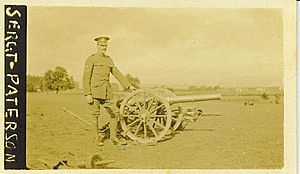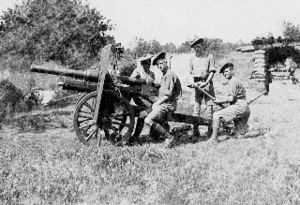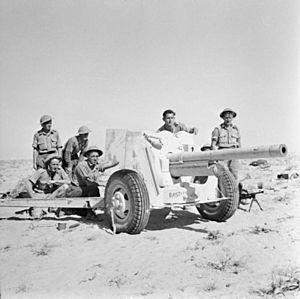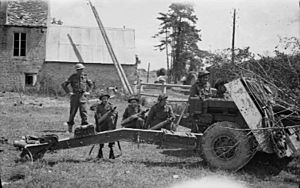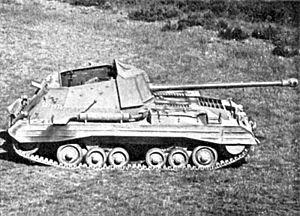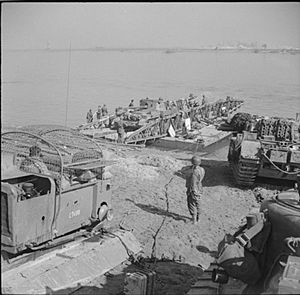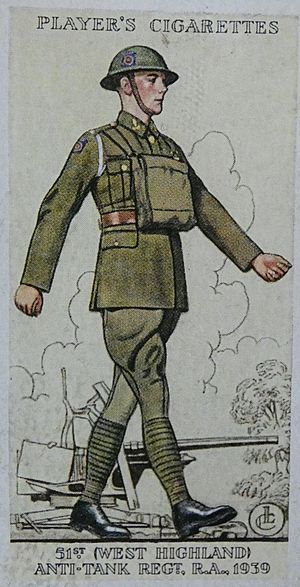1st Argyll and Bute Artillery Volunteers facts for kids
Quick facts for kids 1st Argyll & Bute Artillery Volunteers4th Highland (Mountain) Brigade, RGA 51st (West Highland) Anti-Tank Regiment 254th (West Highland)Anti-Tank Regiment |
|
|---|---|
| Active | 1860–1955 |
| Country | |
| Branch | |
| Type | Artillery Regiment |
| Role | Garrison artillery Coastal artillery Mountain artillery Field artillery Anti-tank artillery Anti-aircraft artillery |
| Part of | 51st (Highland) Infantry Division |
| Garrison/HQ | Oban Lochgilphead Rothesay Dunfermline |
| Engagements | Gallipoli Salonika Saint-Valery-en-Caux North Africa Sicily Normandy Arnhem Rhine Crossing |
| Commanders | |
| Honorary Colonel | J D S Duke of Argyll, KT, KCMG, VD, 18 July 1900 |
The 1st Argyll & Bute Artillery Volunteers was a group of part-time soldiers in the British Army's Royal Artillery. It started in Scotland in 1860 because people worried about a French invasion.
In 1908, it became the only mountain artillery unit in the Territorial Force. This unit fought in major battles like Gallipoli and Salonika during the First World War.
Before World War II, it was the first Territorial unit to specialize in anti-tank warfare. One of its groups was captured in Saint-Valery-en-Caux during the Battle of France. However, other parts of the unit fought bravely in North Africa, Sicily, and North West Europe. This included important events like D Day, the Battle of Arnhem, and the crossing of the Rhine. The unit continued to serve in the Territorial Army until 1955.
Contents
Artillery Volunteers: A New Start
In 1859, many people in Britain were worried about a possible invasion. This led to a lot of excitement for the Volunteer movement. Many new groups of part-time soldiers, called Rifle and Artillery Volunteer Corps, were formed. These volunteers wanted to help the regular British Army if needed.
The 1st Administrative Brigade, Argyll Artillery Volunteers, was officially started on 10 October 1861. Its main office was in Oban. This group included several smaller Artillery Volunteer Corps (AVCs) from Argyllshire:
- 1st Corps: Formed at Easdale on 7 March 1860 (two batteries).
- 2nd Corps: Formed at Tarbert, Loch Fyne, on 12 April 1860 (later disbanded in 1862).
- 3rd Corps: Formed at Oban on 8 March 1860.
- 4th Corps: Formed at West Tarbert on 12 April 1860. It moved to Dunmore in 1864 and Eonachan in 1866 (disbanded in 1874).
- 5th Corps: Formed at Ardgour on 16 January 1861 (one small group, disbanded in 1865).
- 6th Corps: Formed at Campbeltown on 11 February 1861 (grew to two batteries by 1870).
- 7th Corps: Formed at Port Ellen, Islay, on 3 July 1861.
- 8th Corps: Formed at South Hall on 10 September 1861. It moved to Castle Toward in 1878.
- 9th Corps: Formed at Tobermory, Mull on 15 May 1862 (reduced to a half-battery by 1874).
- 10th Corps: Formed at Lochgilphead on 15 May 1862.
- 11th Corps: Formed at Tarbet on 13 February 1866.
- 12th Corps: Formed at Inveraray on 2 April 1867 (its members came from the Furnace Quarries).
The 1st Bute Artillery Volunteers from Rothesay (started 20 March 1862) joined the unit in 1863. The 2nd Bute Artillery Volunteers from Millport, Cumbrae, joined when they formed in 1867. The brigade's main office moved to Lochgilphead in 1864 and then to Rothesay in 1870.
On 25 May 1880, these groups combined to form the 1st Argyll and Bute Artillery Volunteers. It had twelve and a half batteries located in different towns.
Becoming Royal Garrison Artillery
In 1882, all volunteer artillery groups became part of the Royal Artillery (RA). The 1st Argyll & Bute AVC joined the Scottish Division. Later, in 1889, it moved to the Southern Division.
In 1899, the RA split into two main parts: field artillery and garrison artillery. All volunteer artillery units, including this one, became part of the Royal Garrison Artillery (RGA). On 1 January 1902, the unit changed its name to the 1st Argyll & Bute Royal Garrison Artillery (Volunteers). Its main office was in Tarbert.
During the South African War in 1900, 211 men from the 1st Argyll and Bute offered to serve. However, only eight were chosen for active duty.
This unit was very spread out across Britain. For example, one company had small groups in three different places. The soldiers were located in fifteen different areas, some of which were hard to reach in Scotland. Many of the men spoke Gaelic. Because of their different jobs, three training camps were held at different times of the year. The unit also had to keep up 15 shooting ranges.
The unit won many awards for gun practice and exercises. The Easdale companies won the King's Cup at Barry Buddon in 1903. The unit also had a pipe band with over thirty pipers.
Territorial Force: A New Era
In 1908, the volunteer units became part of the new Territorial Force (TF) under the Haldane Reforms. Most of the 1st Argyll & Bute RGA (V) formed the IV (4th) Highland (Mountain) Brigade, RGA. The rest of the soldiers joined a company of the Forth and Clyde Royal Garrison Artillery.
This new brigade was special because it was the only TF mountain artillery unit. It included a company from Lochcarron, Ross-shire, which used to be part of the Highland Artillery Volunteers. The brigade was part of the Highland Division and was set up as follows:
- HQ: Russell Street, Rothesay
- Argyllshire (Mountain) Bty: Campbeltown
- Ross and Cromarty (Mountain) Bty: Lochcarron
- Buteshire (Mountain) Bty: Rothesay
- 4th Highland (Mountain) Ammunition Column: Tarbert
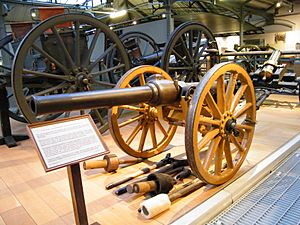
The batteries used the 10-pounder mountain gun. This was a 2.75-inch 'screw gun' that could be taken apart. It was first made for the Indian Army's mountain units.
First World War: Fighting Overseas
Getting Ready for War
The Highland Division was told to get ready for war on 29 July 1914. The official order to mobilize came on 4 August. The IV Highland Mountain Brigade arrived in Bedford on 10 August, where the division gathered.
During the winter of 1914–15, some units left the division to join other groups fighting. On 10 March 1915, the IV Highland Mountain Brigade (except the Bute Battery) moved to the 29th Division. This was a new division made up mostly of regular army units returning from different parts of the Empire. It was chosen for the upcoming Dardanelles operation. The battery left Avonmouth Docks on 16 March, heading for Malta and then Alexandria, where it landed.
Gallipoli Campaign
The 29th Division sailed from Alexandria and landed at Cape Helles on the Gallipoli Peninsula on 25 April 1915. The IV Highland Mountain Brigade and its two batteries fought with the 29th Division during the tough first weeks of the campaign. This included the 1st, 2nd, and 3rd Battles of Krithia, and the Battle of Gully Ravine.
On 29 July, the brigade moved to the 11th (Northern) Division. This was a new group of 'Kitchener's Army' volunteers. They were gathering on the island of Imbros for a new landing at Suvla Bay on 7 August. This landing was also difficult, and the campaign got stuck again.
Once at Suvla, the Argyll Battery moved to the 10th (Irish) Division on 8 August. The rest of the brigade followed on 13 August. The IV Highland Brigade fought with the 10th (Irish) Division throughout the campaign, including the Battle of Hill 60. When the division left on 30 September, the artillery, including IV Highland Brigade, stayed. They fought until the final evacuation of Suvla on the night of 19/20 December. All guns were successfully removed without being lost.
Fighting in Salonika
After leaving Gallipoli, the soldiers went to Egypt to rest. The IV Highland Brigade was part of the Egyptian Expeditionary Force defending the Suez Canal. In September 1916, the brigade was sent to Salonika to help on the Macedonian front. The Bute Battery, which had stayed in Scotland and England, sailed directly from England to Salonika, arriving on 20 September. Each mountain battery in Macedonia had four improved 2.75-inch mountain guns.
The Macedonian Front was a place of trench warfare until late in the war. The final attack began on 1 September 1918. The IV Highland Brigade and its batteries were moved to different groups as needed. The brigade was with the 28th Division from December 1916 until 22 July 1918. The Bute Battery then went to the 27th Division. The rest of the brigade left the 28th Division on 10 September to join XVI Corps. They then joined the 26th Division on 23 September. The Bute Battery rejoined the IV Highland Brigade on 25 September. The campaign ended successfully with the brigade working with the 14th Greek Division.
Between the World Wars
When the Territorial Force was reformed on 7 February 1920, the brigade became the 1st Highland Mountain Bde, RGA. Its commander was Lt-Col W.H. Macalpine-Leny. The TF became the Territorial Army (TA) in 1921. In January 1922, the brigade was renamed the 26th Highland Pack Brigade, RGA. The Bute Battery had a Cadet Corps linked to it. The RGA became part of the Royal Artillery (RA) in 1924.
The brigade, which was the only 'pack' unit in the TA, changed its number to 13th. It was organized as follows:
- HQ: Drill Hall, Tarbert
- 49th (Argyll) Bty: Drill Hall, Oban
- 50th (Bute) Bty: Drill Hall, Rothesay
- 51st (Ross) Bty: Drill Hall, Stornoway
In 1927, the brigade changed its name from 'Pack' to 'Light'. In 1936, it changed again to a field artillery unit called 54th (West Highland) Army Field Brigade.
- HQ: Drill Hall, Tarbert
- 214 (Argyll) Field Bty: Campbeltown
- 215 (Bute) Field Bty: Drill Hall, Rothesay
- 219 (Ross) Field Bty: Drill Hall, Stornoway
- 371 (Oban) Field Bty: Drill Hall, Oban (formed February 1937)
This new role did not last long. By the late 1930s, the army realized it needed special anti-tank (A/T) artillery. On 28 November 1938, the unit became the first such unit in the TA. It was named 51st (West Highland) Anti-Tank Regiment.
- Regimental HQ (RHQ): 130 George Street, Oban
- 201 (Argyll) Anti-Tank Battery: Campbeltown
- 202 (Bute) Anti-Tank Battery: Rothesay
- 203 (Ross) Anti-Tank Battery: Drill Hall, Stornoway
- 204 (Oban) Anti-Tank Battery: Oban
Second World War: Global Conflict
Getting Ready for War Again
After the Munich Crisis in 1938, the TA doubled in size. Existing units split to create duplicate units before World War II began. The 51st Anti-Tank Regiment reorganized as follows:
51st (West Highland) A/T Rgt
- RHQ: 130 George Street, Oban
- 201 (Argyll) A/T Bty: Campbeltown
- 202 (Bute) A/T Bty: Rothesay
- 203 (Ross) A/T Bty: Stornoway
- 204 (Oban) A/T Bty: Oban
61st (West Highland) A/T Rgt
- RHQ: Rothesay
- 241 (Highland) A/T Bty
- 242 (Oban) A/T Bty
- 243 A/T Bty
- 244 A/T Bty
At this time, an anti-tank battery usually had 12 2-pounder guns, organized into groups of four guns.
51st (West Highland) Anti-Tank Regiment
The 51st (West Highland) Anti-Tank Regiment got ready for war in Oban. It trained at Bordon Camp. On 2 February 1940, it went to France to join the British Expeditionary Force (BEF) with the 51st (Highland) Division.
On 22 April, the division went to the Saar Front with the 3rd French Army. They took over a part of the line in front of the Maginot Line forts by 6 May.
Battle of France
The Battle of France started on 10 May when Germany invaded the Low Countries. While most of the BEF moved to defend Belgium, the 51st (Highland) Division stayed on the Saar Front. This area was quiet until 13 May. That morning, the Germans began a heavy bombing and tried to attack, but they were pushed back. Attacks in the following days were not very strong. On the night of 22/23 May, the division was relieved. By this time, German troops had reached Boulogne, cutting off most of the BEF. The 51st (Highland) Division was ordered to move west to meet the British 1st Armoured Division south of the Somme.
The 51st (Highland) Division held the line of the Bresle river, but its forces were very stretched. One battery of the 51st (West Highland) Anti-Tank Regiment had to cover 9 miles (14 km) of the river. The division's attacks against a German crossing over the Somme failed. On 5 June, the enemy attacked along the division's entire front. German Panzers (tanks) raced towards Rouen, getting around the Bresle line. The division was ordered to retreat on the night of 8/9 June.
On 9 June, the division was cut off. That night, a special group called Arkforce was sent to protect the way to Le Havre. This group was formed around the 154th Infantry Brigade and included the 204 (Oban) Anti-Tank Battery. They set off on the night of 9/10 June. Soon after they arrived, the rest of the 51st (Highland) Division was cut off from Le Havre.
The division moved back to Saint-Valery-en-Caux, hoping to be evacuated. But Erwin Rommel's 7th Panzer Division broke through to the cliffs overlooking the harbor. The 201 (Argyll) Battery fought hard to stop them, but its guns were destroyed one by one. The 51st (Highland) Division had to surrender on 12 June. All of the 51st (West Highland) Anti-Tank Regiment, except the 204 (Oban) Battery, became prisoners of war. The regiment stopped existing.
204 (Oban) Anti-Tank Battery: A Separate Fight
Arkforce was successfully evacuated from Le Havre the day after the rest of the division surrendered. The 204 (Oban) Battery was led by Major Donald Carmichael. He refused to let his men leave until their important 2-pounder guns were safely on board. Arkforce was first taken to Cherbourg Naval Base, where a new BEF was supposed to form. Then, they were evacuated to the UK on 15 June (Operation Aerial) after that plan was cancelled.
Back in the UK, the 204 became an independent anti-tank battery. It joined the 29th Independent Infantry Brigade Group. This new group was made of regular infantry battalions that had returned from India. As one of the few fully equipped groups in the UK, the brigade served in South East England, the most threatened area, during the 'invasion summer' of 1940. Then, from November 1940, it was in the West Sussex County Division along the South Coast. The 204 (Oban) Battery left on 5 May 1941 to prepare for overseas service.
The 204 (Oban) Independent Anti-Tank Battery was with the 1st (Guards) Independent Brigade Group from April to August 1942. When that brigade was assigned to the 78th Division for Operation Torch, the battery moved to the 1st Airborne Division on 5 August. On 23 October 1942, it was renamed 2 (Oban) Air-Landing A/T Bty. It was given 6-pounder anti-tank guns and trained for glider operations.
Air-landing Battery Operations
The battery served with the 1st Airborne Division in the Tunisian Campaign. However, its part in the Allied invasion of Sicily (Operation Husky) was cancelled. There were not enough transport aircraft for the invasion of mainland Italy. So, the 1st Airborne Division landed by sea at Taranto (Operation Slapstick). The landing was not opposed, but the battery suffered many casualties. The battery commander, Major James Wilson, another officer, and 22 other soldiers died when their ship, (HMS Abdiel), hit a mine in Taranto harbor and sank.
The 1st Airborne Division left Italy in late 1943 to prepare for operations in North West Europe. The division was not used in the invasion of Normandy (Operation Overlord). Several airborne operations were planned and then cancelled. Finally, the attempt to capture bridges across the lower Rhine (Operation Market Garden) was launched. Just before this, the 2 (Oban) Air-Landing Anti-Tank Battery received some newer 17-pounder anti-tank guns. One 6-pounder group was changed, and three new 17-pounder groups were formed. The new gun could be carried in the large Hamilcar glider.
During the operation, the battery flew in eight Hamilcar and 24 Horsa gliders from RAF Tarrant Rushton. They took part in the Battle of Arnhem. After the operation failed, only one officer and 58 soldiers were evacuated across the river out of 158 who had gone in. The battery commander, Major A.F. Haynes, was captured.
The smaller 1st Airborne Division did not fight again. However, it was sent to free Norway after VE Day (Operation Doomsday). By then, the battery had joined other air-landing batteries to form a new 1st Airlanding Anti-Tank Regiment. It was disbanded in November 1945 after returning from Norway.
61st (West Highland) Anti-Tank Regiment
The 61st (West Highland) Anti-Tank Regiment got ready for war in Rothesay. It was part of the 9th (Highland) Infantry Division. This was the second version of the 51st (Highland) Division. It trained in Scottish Command until 7 August 1940. Then, the 9th (Highland) Division was renamed the 51st (Highland) Division to replace the original one lost at St Valery.
The 244 Anti-Tank Battery left the regiment on 22 September to join a new 84th Anti-Tank Regiment. It was replaced by the 296 Anti-Tank Battery from the 55th (Suffolk Yeomanry) Anti-Tank Regiment on 15 December 1941. The regiment was allowed to use the 'West Highland' subtitle on 17 February 1942. The 296 Anti-Tank Battery left on 10 May 1942 and was replaced by a newly formed 193 Anti-Tank Battery. After training in Scotland, the division sailed for Egypt on 16 June 1942, landing on 12 August.
North Africa Campaign
The division's first battle was the Second Battle of El Alamein. For this battle, the regiment had 16 x 2-pounder guns and 48 of the new Ordnance QF 6-pounder guns. They moved into position at night, hiding during the day. The bombing began at 9:40 PM on 23 October, and the advance started 20 minutes later. The 51st (Highland) Division faced strong resistance. However, the battle started well. Over the next few days, the 51st (Highland) Division made progress. The 'break-out' part of the battle began on the night of 1/2 November. The 51st (Highland) Division broke through, and the Axis forces began to retreat.
The 51st (Highland) Division then chased the enemy to El Agheila and Tripoli in January 1943. By 25 February, they were past Medenine in Tunisia and facing the Mareth Line. The Axis forces attacked on 6 March (the Battle of Medenine), but the British had plenty of warning. The 51st (Highland) Division was positioned along the Wadi Zassar, a natural anti-tank ditch. The anti-tank guns were placed to destroy tanks. The Axis attack was easily stopped.
The Battle of the Mareth Line began on the night of 16/17 March. The 51st (Highland) Division took the outer line with little resistance. The main attack followed on 20/21 March with a huge night bombing. However, little progress was made for the first two days. The line held until other forces got around it from the south. The Axis defense collapsed on 28 March. The next day, the 51st (Highland) Division was on its way to Gabès.
The next Axis defense line was along Wadi Akarit. The bombing for the 51st (Highland) Division's attack began at 4:15 AM on 6 April. The division's attack, as the official history said, 'went like clockwork'. The 61st (West Highland) Anti-Tank Regiment went into action with its 6-pounder guns pulled by tanks. The gun crews rode on the back of the tanks with their ammunition. The tanks then formed a protective screen while the anti-tank gunners dug in under enemy fire. For the first time, the regiment met Tiger tanks. These tanks stayed out of range of the 6-pounders, using their longer-range guns to shell the Highlanders. Axis troops then counter-attacked, and the Highlanders had to fight hard to hold their ground. Some anti-tank guns reached the 7th Battalion Argyll and Sutherland Highlanders (A&SH). However, the 7th Battalion Black Watch was isolated. Still, the positions were held. The chase continued the next day, through Sfax. From 22 April, the division fought in the hills around Enfidaville until the campaign ended on 15 May.
Sicily Campaign
The 51st (Highland) Division then trained for the Allied landings in Sicily (Operation Husky). Along with its 6-pounder guns, the regiment received some of the new 17-pounder anti-tank guns. These were on a temporary Pheasant carriage. The 51st (Highland) Division sailed from Sfax on 8 July. The first attack group landed near Pachino at 3:00 AM on 10 July. There was little resistance, and the 241 Anti-Tank Battery's guns were brought ashore and set up that morning. The larger Landing Ships, Tank arrived around noon, and the rest of the regiment landed that night. The 242 Anti-Tank Battery was assigned to the 153rd Brigade, and the 243 Battery to the 152nd Brigade. The 193 Anti-Tank Battery stayed with the main headquarters as a reserve. The division then moved towards Vizzini and Francofonte, where it met its first resistance on 13 July. The 243 Anti-Tank Battery fired the first shots of the campaign at a pillbox with great success. After that, the division used anti-tank guns close to the infantry to attack pillboxes and machine gun posts in buildings.
The division continued towards the Dittaino river. It sent a mixed group of infantry and tanks ('Arrow Force'), along with the 243 Anti-Tank Battery, to cross the Dittaino and try to capture Paternò. They got across on 17 July, but further advance was stopped. So, on the night of 20/21 July, the division attacked the main enemy defenses at Gerbini Airfield. The 7th A&SH attacked with support from some anti-tank guns and tanks. Although the attack succeeded, strong counter-attacks by the Hermann Goring Division pushed the Highlanders out the next morning. After this, the 51st (Highland) Division went on the defensive. More counter-attacks and heavy shelling on 23/24 July caused more casualties. Because of losses in men and guns, the 193 Anti-Tank Battery used three captured German 75 mm anti-tank guns.
The division was relieved on 30 July and moved to attack Adrano (the battles around Etna). The anti-tank guns were gathered at Sferro under fire. This was so they could be quickly used once the infantry reached their targets. The 51st (Highland) Division took its new crossings over the Dittaino on the night of 31 July/1 August. The anti-tank guns were in action by daylight. Enemy tanks counter-attacked at 2:00 PM, and a few tanks got close enough to be destroyed by the anti-tank guns. Paternò fell on 4 August, Biancavilla on 6 August. The division then began a 50-mile (80 km) move north of Zafferana on 12 August. By this time, the Axis forces were leaving Sicily, which was completed on 17 August. During the Sicily campaign, the regiment lost 1 officer and 5 soldiers killed, 1 officer and 40 soldiers wounded, and 2 soldiers missing.
The 51st (Highland) Division did not take part in the later Italian Campaign. It had been chosen for Operation Overlord.
Normandy Campaign
The 51st (Highland) Division was in the first group of follow-up forces for Operation Overlord. On 2 June 1944, it sailed from East India Docks, London, for Normandy. It began landing on 7 June (D + 1). The first troops ashore on D + 1 included the 242 Anti-Tank Battery and a 17-pounder group from the 193 Anti-Tank Battery. The division then got stuck for several weeks fighting around 'The Triangle' north-east of Caen. It then helped the 3rd Division's attack during Operation Goodwood on 18 July.
On 8 August, the 51st (Highland) Division led the II Canadian Corps' attack towards Falaise (Operation Totalize). The attack began before dawn. By first light, the breakthrough was going well, and several villages were captured. The 4th Canadian and 1st Polish Armoured Divisions then moved through to continue the advance. The Canadians renewed the advance to Falaise on 14 August in Operation Tractable. The 51st (Highland) Division attacked towards the Laison Valley on the left side. By 21 August, the Falaise Pocket was closed, and the division was moving east towards Lisieux. It was then sent across the Seine river to free St Valery, where the original division had surrendered in 1940.
The 51st (Highland) Division then prepared to attack Le Havre (Operation Astonia). This was a large operation with heavy air and artillery bombing and tank support. This scared the enemy into giving up. This was followed by a similar attack to take Boulogne (Operation Wellhit), and operations to keep an eye on Dunkirk.
Low Countries Battles
The division then moved a long distance to the Antwerp area in late September. It then spent three weeks in the line at Sint-Oedenrode. The 61st (West Highland) Anti-Tank Regiment was placed to cover the bridges captured during Operation Market Garden. They fired at enemy-occupied houses or used long-range harassing fire. On 13 October, the 193 Battery helped stop a German attack with their anti-tank guns and Bren guns. The 241 Battery also fired 2-inch mortars. The regiment also practiced crossing rivers. They used small boats to carry Jeep-towed 6-pounders and makeshift rafts with outboard motors to carry 17-pounders and Quad tractors.
On 23 October, the regiment took part in Operation Colin, a division attack on Schijndel. Schijndel was taken easily, and the division pushed on to take Vught on 25 October.
On 4 November, the division began an operation against 'The Island' west of 's-Hertogenbosch. This involved crossing the Afwaterings Canal. The 193 Battery on the right and the 243 Battery on the left fired to trick the enemy. This included providing covering fire from 12 Bren guns for the infantry crossing.
On 14 November, the division crossed the Willems Canal near Weert (Operation Ascot). They then moved to the Zig Canal and crossed it on 17 November with much less preparation. Once the canal was bridged, the 61st (West Highland) Anti-Tank Regiment's guns were set up to defend the crossing. They were helped through the bad conditions by being towed by Kangaroo armored personnel carriers.
The 51st (Highland) Division was then tasked with holding the wet, low-lying land between Nijmegen and Arnhem. This area had been captured during Operation Market Garden. Some of it later had to be evacuated (Operation Noah) when the Germans broke the dykes and flooded the area. In early December, the division was pulled out of the line to rest.
In December, the division was suddenly moved south to respond to the German breakthrough in the Ardennes (the Battle of the Bulge). Then, in January, the 51st (Highland) Division fought its way into the side of the 'Bulge' in winter conditions.
In the winter of 1944–45, the anti-tank batteries of infantry divisions were changed. They now had one group each of towed 6-pounders, towed 17-pounders, and Archer self-propelled (SP) 17-pounders on Valentine tank chassis.
Rhineland Campaign
The 51st (Highland) Division then fought in the Reichswald (Operation Veritable). It began at 5:00 AM on 8 February with a huge artillery preparation. The Highlanders attacked and reached their targets by 11:00 PM that night. The 61st (West Highland) Anti-Tank Regiment's batteries were attached to the infantry brigades, but the guns were not actually needed. On 10 February, the SP group of the 242 Battery attacked enemy machine gun posts and houses. However, several Archers from the 242 and 243 Batteries got stuck or were damaged by enemy anti-tank fire. The slow advance continued through Gennep on 11 February, and the gunners suffered from enemy shelling. One of the regiment's officers, while scouting in a Valentine observation post (OP) tank on 12 February, attacked and drove off an enemy group in the forest. On 13 February, the SP guns destroyed a tank and a church steeple at Hekkens used as an enemy observation post. Other gunners drove off local attacks by German paratroopers with small arms fire. On 16 February, the 243 Battery's SP and towed 17-pounders supported a night attack by the 152 Brigade on Asperden. The final part of the operation for the 51st (Highland) Division began on 18 February against Goch, which was successfully taken after tough fighting.
The division played a leading role in the Rhine crossing. The division then continued through Isselburg and Anholt.
The division reached the Dortmund–Ems Canal on 8 April. After a short stop at the canal, it quickly advanced towards Bremen, facing only small delays. It reached Delmenhorst on 20 April and moved closer to the center of Bremen. The German surrender at Lüneburg Heath ended the fighting on 5 May.
The 61st (West Highland) Anti-Tank Regiment was put on hold on 1 April 1946.
After the Wars
When the TA was reformed on 1 January 1947, the 61st (West Highland) Anti-Tank Regiment was officially disbanded. The former 51st (West Highland) Anti-Tank Regiment was reformed as the 254 (West Highland) Anti-Tank Rgt. Its main office was in Dumbarton, and it was part of the 51st/52nd (Lowland) Division. In 1950, the regiment changed its role to become the 254 (West Highland) Light Anti-Aircraft Regiment. In 1954, it joined with the 417 (Dumbartonshire) (Mixed) Heavy Anti-Aircraft Rgt. This 417th unit was originally the Clyde RGA, which the 1st Argyll & Bute Artillery Volunteers had helped to form. The combined regiment went back to being the 254 (West Highland) Anti-Tank Regiment, with one battery from the 417th.
Finally, on 10 March 1955, the regiment joined the Greenock-based 277th (Highland) Field Rgt. This marked the end of the Argyll & Bute unit's history.
Uniforms and Badges
The early uniforms of the volunteers were very different. Colonel F. Campbell, who commanded the unit from 1884 to 1903, wrote about them. He said that each group had its own uniforms, like tunics or shirts, and caps with different colored bands. Officers wore whatever old uniforms they had, even if they were from cavalry or infantry. They had all kinds of swords.
In 1860, the 3rd Corps wore blue uniforms with red trim, white pouch belts, and black waistbelts. They also wore tall, furry hats called busbies. The 4th Corps wore blue flannel jumpers and trousers. They also wore a wide Kilmarnock bonnet, like the ones worn by the Tarbert fishermen who made up most of the group.
When the TF was created in 1908, the IV Highland (Mountain) Brigade wore standard brass shoulder titles. These showed 'T' over 'RGA' over the area name. However, each of the three batteries had its own title: T/RGA/ARGYLL, T/RGA/ROSS&CROMARTY, and T/RGA/BUTE.
While serving in Macedonia in 1916, the IV Mountain Brigade was given Balmoral bonnets for officers and Kilmarnock bonnets for other ranks. They wore Tartan flashes behind their RA gun badge. Each battery had a different tartan:
- HQ Bty: Royal Stewart
- Argyll Bty: Campbell
- Ross Bty: Hunting Stewart
- Bute Bty: Mackenzie
Commanding Officers
Here are some of the officers who led these units:
- Major-General J. Campbell, CB, who had a Waterloo Medal. He became a Major on 10 October 1861 and a Lieutenant-Colonel on 23 July 1863.
- John Campbell Marquis of Lorne (later 9th Duke of Argyll), KT, GCMG. He was appointed Lt-Col Commandant on 13 July 1866.
- Col Frederick Campbell, a former Lieutenant in the RA, CB, VD. He was appointed on 21 March 1884.
- Col John W Stewart, VD. He was appointed on 1 August 1903.
- Colin G. P. Campbell, a former 2nd Lieutenant in the Scots Guards. He was appointed on 17 February 1906.
Honorary Colonels
These individuals served as Honorary Colonel for the unit:
- John Campbell, 9th Duke of Argyll, who used to be a Commanding Officer. He was appointed on 18 July 1900.
- C. McL. Robertson, DSO, TD. He was appointed on 3 January 1923.
- T. McElvie, CMG, TD. He was appointed on 3 January 1929.
- Maj Sir Colin W. McCrae, CVO, CBE. He was appointed on 3 January 1935.
Memorial
There is a special memorial in Stornoway. It honors the men of the 1st Ross-Shire Mountain Battery who died in Egypt, at Gallipoli, and in the Balkans during the First World War. It also remembers those who died during the Second World War. The memorial is a stone cairn (a pile of stones) with a thistle on top. It stands in front of the Drill Hall and TA Centre at the crossroads of Church and Lewis Streets.


